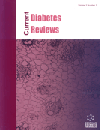
Full text loading...
We use cookies to track usage and preferences.I Understand
Dementia is the primary cause of disability and dependence among the elderly population worldwide. The population living with dementia is anticipated to double in the next 17 years. Recent studies show the fact that compared to people without diabetes, people with Type 2 Diabetes (T2D) have about a 60% increased chance of developing dementia. In addition to cholinergic function being downregulated, improper insulin signalling also has a negative impact on synaptic plasticity and neuronal survival. Type 2 diabetes and dementia share various similar pathophysiological components. The ageing of the population and the ensuing rise in dementia prevalence are both results of ongoing medical advancements. It is possible that restoring insulin signaling could be a helpful therapy against dementia, as it is linked to both diminished cognitive function and the development of dementia, including AD. This review article comprehensively focused on scientific literature to analyze the relationship of Dementia with diabetes, recent experimental studies, and insight into incretin-based drug therapy for diabetes-related dementia.

Article metrics loading...

Full text loading...
References


Data & Media loading...

